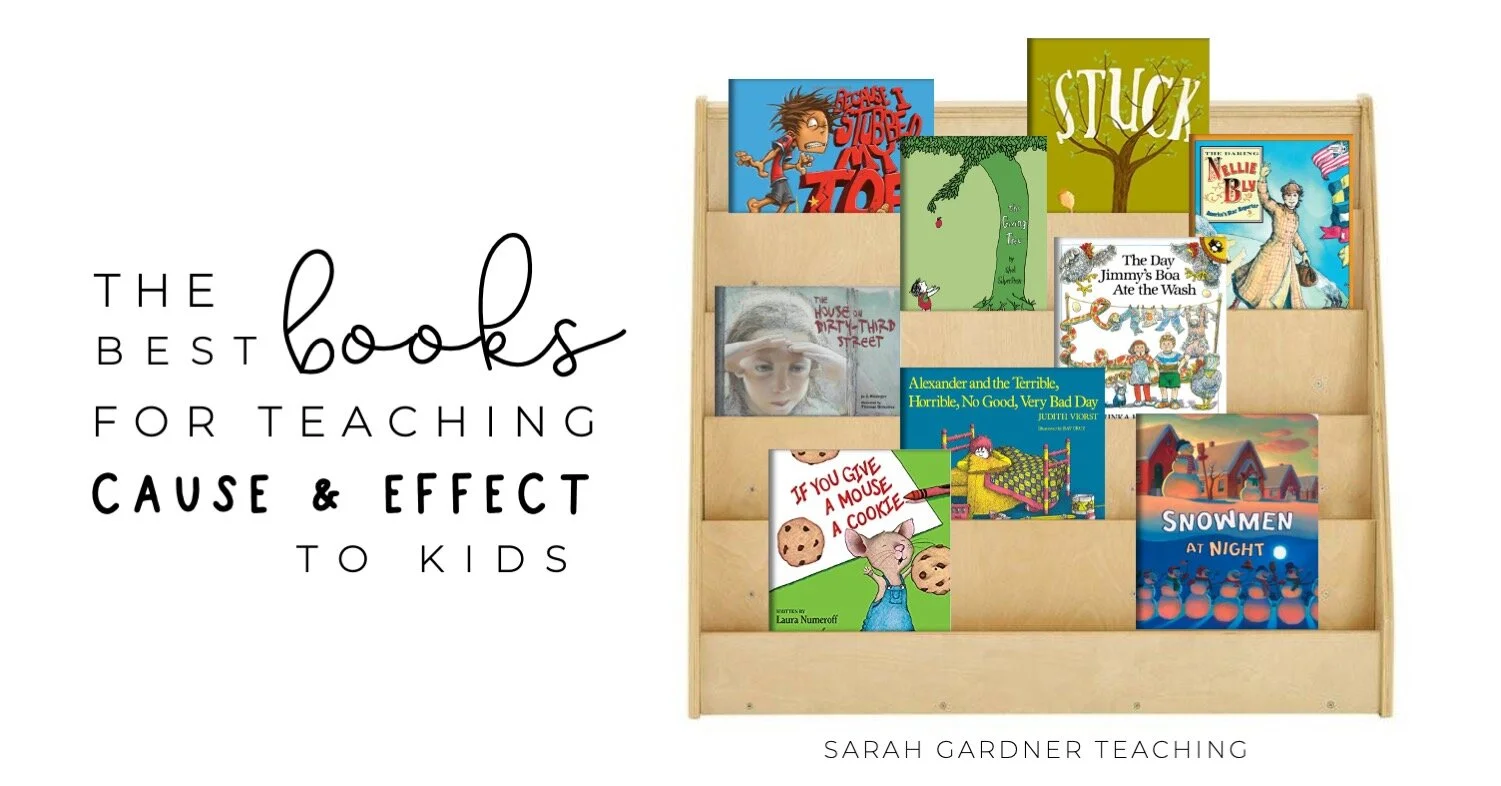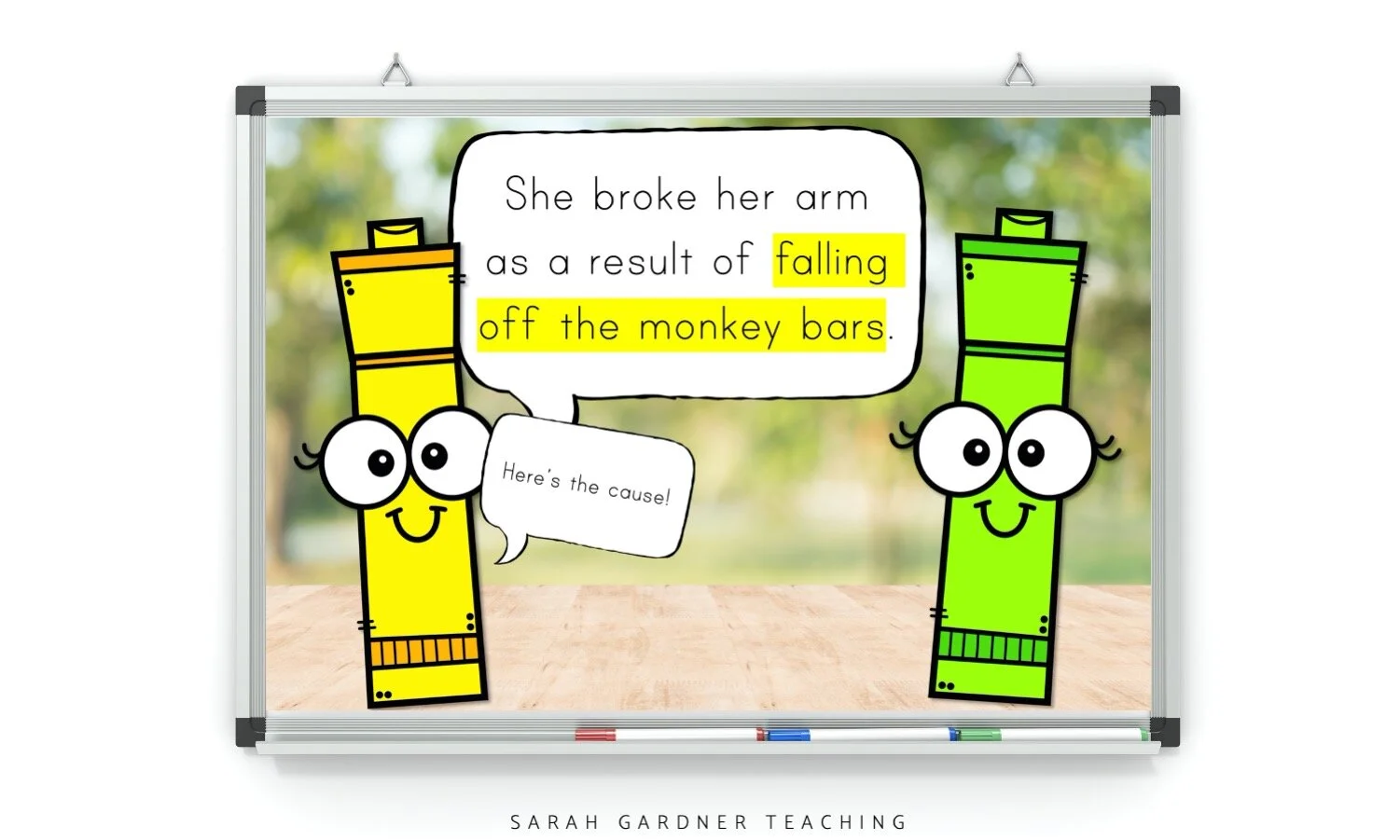Teaching Cause & Effect to Kids: The Best Read Alouds to Use
Children learn cause and effect relationships very early on in life, even though they might not be able to attach a name to them. Think about all of the common lessons that little ones understand that are examples of cause and effect.
Cause: touches pan of cookies that are fresh out of the oven
Effect: gets burned
Cause: jumps off the swing set mid-swing
Effect: ouch, their leg hurts later that night
Cause: brushes teeth in the morning and at night
Effect: gets praised at the dentist for good oral hygiene and no cavities
I threw in the last example because I find that when I’m teaching cause and effect, my students tend to only think of examples with negative outcomes. But we all know that there are positive “effects” that come from positive “causes” - they’re just sometimes more difficult to tease out.
Cause: studies for spelling test
Effect: gets an A
Cause: reads every day for 20 minutes
Effect: becomes a strong reader
If my students get confused when I am teaching cause and effect using literary examples, I like to remind them that we all see examples of it every day in our lives, whether or not we realize it. Students will take more ownership in learning if they understand how it relates to them. Check out this post and this post for some helpful hints on teaching cause and effect. Both give excellent ideas on how to explain it in manageable ways and provide activities and charts to use simultaneously.
Below I have listed nine books that I like to use as tools when teaching cause and effect. Some of the selections use clear examples of the concept, and others will require deeper analysis to identify.
Please note that this post contains affiliate links, meaning, at no additional cost to you, I will earn a small commission if you click through and make a purchase.
TIPS FOR TEACHING CAUSE & EFFECT
1. Make it Visual
I don’t know about your students, but mine love any excuse to bust out their highlighters. I love to use highlighters when teaching cause and effect because it very clearly separates the cause from the effect and it gives students a chance to see that the effect may come first in a sentence, like in the example below.
2. Teach Signal Words
We spend quite a bit of time discussing signal words in our study of cause and effect. Signal words like since, because, so, as a result of, etc. can give us clues about whether we are looking at the cause or at the effect.
3. Use Fishbone Diagrams
Most lessons about cause and effect for young students list one cause that is directly tied to one effect, but we know that’s just not how life works! One cause (for example, waking up late) can have many effects (missing the bus, being late to school, forgetting homework, etc). This also works in reverse - many causes can go together to create one effect. I like to use a fishbone diagram with my students to demonstrate this. In the example below, we’re showing that “Max is healthy” is the effect. We write the effect in the “head” of the fish. There are many causes that contribute to Max’s health - we list those on the “bones” of the fish. All of these causes point to the one effect.
BOOKS FOR TEACHING CAUSE & EFFECT
Snowmen at Night by Caralyn Buehner
A boy makes a snowman one day but is surprised the next day to see that the snowman looks completely different-- he is slumped over, hat falling off, etc. The character uses his imagination to brainstorm what could have occurred to make that happen. He envisions snowmen skating, drinking hot cocoa, and playing baseball. This is a highly charming story with adorable illustrations and is perfect for the holiday season. Additionally, I like it because it teaches that sometimes we have to hypothesize a cause to an effect we see, as it’s not always obvious.
Alexander and the Terrible, Horrible, No Good, Very Bad Day by Judith Viorst
This story begins with Alexander falling asleep with gum in his mouth and waking up with it in his hair. I can’t disagree with Alexander on that one-- that is a pretty rough start to the day! From the character’s perspective, this shaky start began a negative spiral that ruined the rest of his day. Events such as not finding a toy in his cereal, not getting the window seat, having a cavity at the dentist, and getting in a fight with a friend all contribute to Alexander’s terrible, horrible, no good, very bad day. This book clearly illustrates cause and effect with the way each situation snowballs into the next. You could easily integrate discussions on social-emotional skills such as taking responsibility for one’s actions.
If you’ve ever read this story, you know that there are many causes of Alexander’s terrible, horrible day. I love to use this book to help introduce the fishbone diagram concept.
Stuck by Oliver Jeffers
Floyd gets his kite stuck in a tree and spends the rest of the day trying to get it out. He throws shoes, ladders, paint, chairs, trucks, and many other items into the tree to try to knock the kite loose. Finally, he has an idea to get a saw, which he throws at the tree, and successfully releases the kite. This story promotes the use of imagination. I could see a silly class brainstorming session occurring on the type of objects we could use to throw at a tree in an attempt to get our kite back. The only thing I dislike about this story is the author’s choice to have a child throw a saw at the tree because it might give students the idea that throwing a sharp object could be okay. On the other hand, it’s a good time to have a conversation about not trying something just because you see it on tv or in a book.
The Giving Tree by Shel Silverstein
If you’ve never read The Giving Tree, it is a beautiful story. The book follows a young boy who loves a particular tree. As a child, he would enjoy everything that the tree had to offer by gathering the leaves, climbing the trunk, and eating the apples. As the boy grew up, the tree was often lonely. The tree longed to play like they used to, but the boy, now a man, was now interested in worldly things. He took the apples from the tree so he could sell them and make money. The next time he comes back, he cuts off the branches, and the final time he cuts the tree down to its trunk. This story has a serious theme and is a tool to teach cause and effect and creates an excellent opportunity to talk with the students about the importance of treating nature with care and remembering that it’s here for more than just to be used at our disposal.
The Day Jimmy’s Boa Ate the Wash by Trinka Hakes Noble
If the last book was a bit too serious for your students, this one swings in the exact opposite direction. This silly book is about a little girl returning home from a field trip and explaining the details of the day to her mom. The events are fast-paced, hilarious, and will definitely keep your students engaged, while also illustrating a domino-style cause and effect in a relatable way.
If You Give a Mouse a Cookie by Laura Numeroff
This has been one of my favorite children’s books since I was a child myself. As a student, I didn’t realize how well it illustrated cause and effect. I remember thinking the story was so humorous. The gist of the book is that a mouse is given a cookie, and then he wants milk, and then he needs to go to the restroom, and then he needs to look in the mirror, etc. One thing leads to another until the boy is very regretful of feeding the mouse the cookie. It is so cute and gives students very understandable examples of cause and effect. There are a lot of spin-offs of this book and they all would work just as well to teach the concept. Just pick your favorite!
Because I Stubbed My Toe by Shawn Byous
This read-aloud would be a perfect introduction for cause and effect for littles. It is about a little boy who stubs his toe, and then a whole series of events follow it, such as shaking the chair, scaring the dog, etc. The story is easy to follow and the examples are concrete, so the students should understand how one event could lead to another.
The House on Dirty-Third Street by Jo. S Kittinger
This story is about a mom and her daughter moving into a new house that needs a lot of work to make it livable. At first, the mom is very optimistic and is so excited to have a home they can make their own. However, as the work continues, they grow so weary and realize it’s way more work than the two can accomplish on their own. They go to church, and later a man they met there came over to help them complete some of the tasks. Slowly but surely, many people from church came over to help get the house fixed up. Not only does this book teach cause and effect, but it also teaches how a team of people can accomplish more toward a common goal than one can by themselves.
The Daring Nellie Bly: America’s Star Reporter by Bonnie Christensen
I didn’t know much about Nellie Bly until I became a teacher. I read my students a story about her and I didn’t think a lot of it. However, my kids went crazy for it, and we had such meaningful conversations about gender inequality and women in the workforce. Nellie Bly was a famous newspaper correspondent who was famous for events such as committing herself to an asylum to reveal the mistreatment going on there, being the first reporter (male or female) to report on the front lines in WWI and her trip around the world in 72 days. It may seem like a long time ago to students, but Nellie was a trailblazer for women. It is a more abstract way to discuss cause and effect, but students, especially girls, can understand how Nellie’s contributions affect their lives.






















